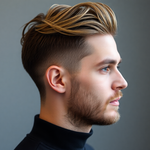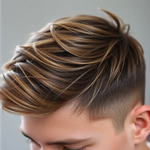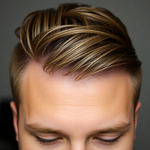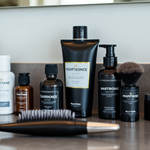
Semi-Permanent Hair Color Playbook: Shade-First Tricks to Multiply Looks from a 9‑Piece Men's Capsule Wardrobe
20 October 2025
Share
Semi-Permanent Hair Color Playbook: Shade-First Tricks to Multiply Looks from a 9‑Piece Men's Capsule Wardrobe
Intro — the fast route to more looks with less stuff
Struggling to look put-together without buying more clothes? The Semi-Permanent Hair Color Playbook: Shade-First Tricks to Multiply Looks from a 9‑Piece Men's Capsule Wardrobe shows how one intentional hair move plus a tight, quality wardrobe multiplies your style options. In 80–95 words: pick a semi-permanent shade that complements your skin tone and the temperature of your capsule, learn simple application and upkeep, then use a handful of styling swaps to create distinct, repeatable looks for work, weekends, and dates.
Why the shade-first strategy actually wins
Most guys focus on clothes first. But the color framing your face does more to set first impressions than any jacket. A shade-first strategy means you choose hair color with outfits in mind — warm vs cool, low vs high contrast — then let the hair anchor your wardrobe. That small pivot reduces decision fatigue, increases coherence across outfits, and gives you a sharper, more intentional look with the same 9 pieces.
Semi-Permanent Hair Color Playbook: Shade-First Tricks to Multiply Looks from a 9‑Piece Men's Capsule Wardrobe
This playbook breaks the process into three practical phases: choose your shade, apply and maintain it safely, and map shade–outfit pairings to specific capsule combos. Use semi-permanent dye because it fades gracefully, avoids long-term commitment, and generally keeps hair healthier than repeated permanent coloring.
How semi-permanent color works (short, practical science)
- Semi-permanent dyes deposit color on the hair cuticle rather than penetrating the cortex fully; that means color fades over 4–12 washes depending on product and porosity.
- They often contain conditioning agents, so treated hair looks glossier and less damaged than with permanent dye.
- No developer or peroxide is required for most shades that are within 1–2 levels of your base color; darker or more dramatic shifts may need professional help.
9-piece men's capsule wardrobe — the breakdown and why each piece matters
The goal: maximum combo potential, minimal fuss. Keep fit and fabric quality high; neutrals plus one texture-driven piece give you range.
- White crew tee — the universal base for casual and layered looks.
- Black slim tee — contrast and edge; great for nights out.
- Navy button-down — smart-casual anchor that works with chinos or denim.
- Gray merino sweater — lightweight, breathable, and versatile.
- Dark denim jeans — the most adaptable bottom you’ll own.
- Charcoal chinos — cleaner alternative to denim for elevated looks.
- Versatile jacket (bomber or lightweight blazer) — instant outfit polish.
- Clean white sneakers (Menll.com EcoSneak recommended) — modern, sustainable, and comfortable; they lift casual fits.
- Leather boots (brown or black) — rugged, date-ready, or work-appropriate depending on pairings.
Shade selection — a step-by-step decision map
Pick your shade based on three things: skin undertone, desired contrast, and your capsule's dominant palette.
- Determine your undertone: cool (pink/blue veins), warm (greenish veins), or neutral.
- Decide contrast level: high contrast = darker hair vs lighter skin (sharp, youthful); low contrast = hair closer to skin tone (sophisticated, soft).
- Match temperature: if your capsule is heavy on navy/grays/black, lean cool ash or dark neutral browns. If your capsule uses olive, tan, and warm browns, pick warm brown or soft honey highlights.
- Plan intensity: pick semi-permanent shades within 1–2 levels of your natural color for natural results; choose slightly bolder tones for nightlife or content creation.
Shade cheat-sheet by skin tone and age
- Pale skin, 18–30: medium ash brown or cool dark brown for a modern, high-contrast look.
- Pale skin, 30–45: soft warm brown tones or subtle highlights to avoid a washed-out effect.
- Olive skin: golden brown, chestnut, or caramel highlights to enhance warmth.
- Darker skin: deep espresso, chocolate, or warm highlights; avoid overly light shades unless you want a high-fashion statement.
Mapping shade temperature to capsule pieces
Think in two buckets: cool shades and warm shades. Pick the bucket that matches your wardrobe's dominant tones.
- Cool shades (ash, cool brown, espresso): best with navy, black, gray, and blue denim.
- Warm shades (golden brown, auburn, honey): pair naturally with olive, tan, brown leather, and warm knitwear.
12+ tested outfit recipes tied to shade choices
Below are replicable looks that use the 9-piece capsule. Each entry includes the shade type that sharpens the outfit.
- White tee + dark denim + EcoSneak = casual crisp. Shade: cool neutral brown for clean lines.
- Black tee + bomber + leather boots = evening edge. Shade: deep warm brown or dark espresso for depth.
- Navy shirt + charcoal chinos + boots = client-ready smart-casual. Shade: dark ash brown for subtle professionalism.
- Gray merino + white tee + denim = layered weekend. Shade: soft warm highlights to lift the face.
- Button-down + blazer + chinos = date-night. Shade: saturated dark brown or espresso to create strong facial definition under soft lighting.
- Black tee + gray sweater + denim = layered minimal. Shade: ash brown for a contemporary, low-sheen finish.
- White tee + bomber + boots = casual rugged. Shade: warm chestnut to complement brown leather.
- Navy shirt + denim + EcoSneak = city casual. Shade: neutral brown to bridge smart and casual elements.
- Gray sweater + chinos + boots = office-ready relaxed. Shade: deep walnut for maturity and depth.
- Black tee + blazer + denim = elevated night out. Shade: near-black espresso for maximum edge.
- White tee + chino jacket + sneakers = travel-day ease. Shade: light warm highlights to appear rested on flights.
- Button-down + gray sweater + boots = layered interview look. Shade: cool dark brown to emphasize seriousness and clarity.
Application guide — professional results at home
- Gather tools: semi-permanent dye, tint brush, plastic bowl, gloves, clips, old towel, wide-tooth comb, color-safe shampoo and conditioner.
- Strand and patch test: always test 48 hours for allergies and color accuracy on a hidden strand.
- Prep hair: start with dry or slightly damp hair that was washed 24–48 hours earlier for best adherence.
- Mix and apply: follow product instructions. For all-over color, work in sections from back to front and ensure full saturation.
- Set timer: typical processing is 20–40 minutes depending on product and desired depth.
- Rinse in cool water until the water runs clear; condition using the product's recommended treatment to seal the cuticle.
Maintenance calendar — keep the shade sharp for months
- Week 1–4: avoid daily shampooing. Use color-safe, sulfate-free shampoo twice weekly.
- Every 2–4 weeks: use a color-depositing conditioner or glaze to refresh tone (especially for ash and red tones).
- Monthly: deep-conditioning mask to maintain shine and reduce fade.
- Every 8–12 weeks: reassess; semi-permanent hues may require a touch-up or a reapplication depending on fade and desired continuity.
Styling haircuts and finishes that amplify shade choices
Your cut affects how color reads. Short crops with texture show dark, matte shades well; longer layers benefit from subtle highlights to add dimension.
- Textured crop: use matte paste for cool shades to emphasize structure.
- Undercut or fade: darker, saturated shades make contrast cleaner and sharper.
- Longer, layered styles: add warm or cool babylights to break flatness and catch light in motion.
Troubleshooting common issues
- Color too warm on a cool intent: use an ash-toning color-depositing conditioner to neutralize brassiness.
- Uneven coverage: apply a second, shorter processing application, focusing on lighter areas; or seek a professional fix if too patchy.
- Fast fading: reduce wash frequency, use cooler water, and switch to a color-depositing shampoo once a week.
- Scalp irritation: stop use and consult a dermatologist; do not reapply until cleared.
Product recommendations and where Menll helps
Choose semi-permanent dyes from reputable brands with clear tone descriptions (ash, neutral, warm) and conditioning ingredients. For gear, Menll.com’s EcoSneak is a smart shoe choice to pair with multiple capsule looks, and Menll’s outerwear collection provides layering pieces that work with both warm and cool shades. Explore Menll.com’s footwear and outerwear collections for staples that harmonize with your chosen hair temperature: Menll.com Shoes and Menll.com Outerwear.
Safety, allergies, and expert references
Patch tests are non-negotiable. For detailed safety info and allergy considerations, see an authoritative guide on hair dye safety from WebMD: WebMD - Hair Dye Safety. If you have a history of allergic reactions or scalp issues, consult a dermatologist before applying any dye.
Content and visuals to produce for maximum impact
Make the process shareable and searchable. Create a short reel showing before/after with the same outfit, a behind-the-scenes application clip, and a carousel of 6 outfit recipes that tie directly to shade choices. Suggested captions and alt text help SEO and accessibility.
- Hero image alt text: 'Man before and after semi-permanent hair color showing shade-first transformation'.
- Reel idea: 10-second transitions from white tee to blazer, switching hair shade in the middle for dramatic effect.
- Infographic: a printable mapping of 9-piece capsule + 6 shade options = 18 outfit outcomes.
SEO meta and publishing checklist
Make sure the primary keyword appears naturally in the title, intro, one H2, and 2–3 times across the body. Use clean, keyword-friendly URLs such as 'menll.com/blog/semi-permanent-hair-color-playbook'. Include one external authority link and 1–2 internal links. Suggested meta assets below.
Meta title: Semi-Permanent Hair Color Playbook — Shade-First Tricks (55 characters)
Meta description: Shade-first semi-permanent hair color strategies to multiply looks from a 9-piece men's capsule wardrobe. Step-by-step shade selection, upkeep, and outfit pairings. (156 characters)
FAQ — quick answers to the common questions
- How long does semi-permanent last? Typically 4–12 washes; longevity depends on porosity, product, and wash routine.
- Can I go lighter with semi-permanent? Not effectively — semi-permanent darkens or shifts tone. For lighter results, you need lifting or professional color services.
- Is at-home okay for first-timers? Yes, for small shifts within 1–2 levels of your natural color. For dramatic changes, consult a pro.
- How often should I touch up? Every 6–12 weeks or use color-depositing treatments between full applications.
Final checklist & next moves
- Decide your shade temperature and test a strand.
- Buy a semi-permanent dye and the maintenance products you need (color-safe shampoo, deposit conditioner, deep conditioner).
- Plan three outfit shoots using your 9-piece capsule to see how color shifts mood and contrast.
- Share results and ask for feedback — you’ll refine quickly with real-world wear.
Closing — try the shade-first system this week
Small investments in shade and fit go further than a closet overhaul. The Semi-Permanent Hair Color Playbook: Shade-First Tricks to Multiply Looks from a 9‑Piece Men's Capsule Wardrobe is designed to be practical: pick a shade that works with your capsule, apply safely, maintain simply, and test a handful of outfit combos. Want a personalized recommendation? Tell me your skin undertone, current hair level (light/dark), and the three dominant colors in your wardrobe — I’ll recommend one shade and three outfit pairings to try first.
Soft CTA: Drop your details or browse Menll.com for sustainable basics that pair perfectly with your new shade.
Prev post

Texture & Tone: How Semi-Permanent Hair Color Helps Men Pair Fabrics and Stretch a Minimal Capsule Wardrobe
Updated on 21 October 2025






